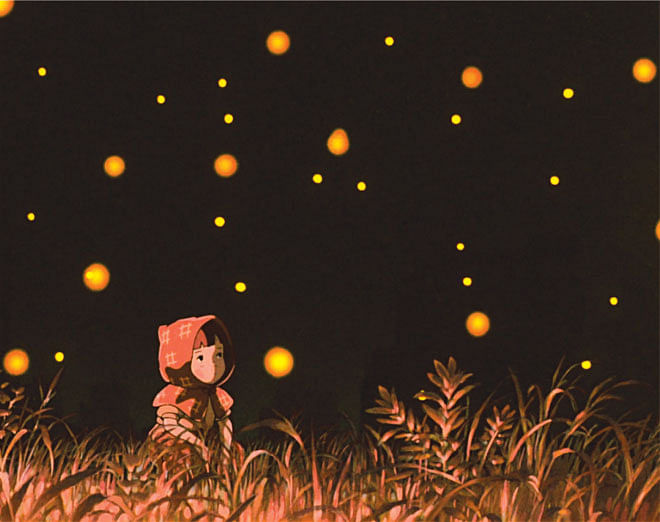THE GRAVE of the Fireflies

The Grave of the Fireflies is a story that could not have been adapted to film outside the medium of Japanese animation; certainly the plot of Akiyuki Nosaka's novel could have been adapted to live action, and possibly that would have been a perfectly good film in its own right. But it would merely be a shade of what Isao Takahata and the rightly-lauded Studio Ghibli have achieved. Ironic, then, that the ideal medium for the expression of this poignant drama of war and survival should be one whose cultural connotations prevent so many from ever hearing of it. (Not only is it a 'cartoon', it is a Japanese cartoon.) The Grave of the Fireflies is no secret to anime aficionados and lovers of film, but to mainstream audiences it remains largely unknown.
The plot follows the 14 year-old Seita and his sister, a toddler named Setsuko, as they attempt to survive the final year of World War II. The film opens in 1945 with Seita dying alone of malnutrition in a railway station shortly after the Japanese surrender. Setsuko too has passed away, but the siblings are reunited in death, and the story is told through flashbacks with sparse narration by Seita's spirit. Seita and Setsuko had lost their home and their mother in the firebombing of Kobe, and had to go live with their distant aunt (their father was with the navy at sea.) They are at relative peace there, and Seita treats Setsuko to a secret stash of fruit drops and every night they go to the lake to play among the fireflies. This is not to last as their aunt becomes increasingly disgruntled with their presence in her home and scolds Seita for not working for his keep. His pride wounded, Seita takes Setsuko to live at an abandoned bomb shelter near the lake with the fireflies. What begins as a youthful burst of rebellion graduates into disaster as Seita proves not quite able to keep both of them fed and healthy.
The central pair is exquisitely-voiced and animated. (I would recommend watching it in Japanese with subtitles to fully enjoy the former quality; the English dub is merely competent.) Seita is full of vitality and resourcefulness, mature beyond his years. Setsuko is as cute as a button, and her emotions are amazingly realized; here is a child of flesh and blood in all her joy and sorrow, and no mere drawing with a voice actor. Neither sibling is idealized; Setsuko can be wilful and petulant as any child, and the tragedy we watch unfold could easily be reversed if Seita would only swallow his pride and return to their aunt (something that is explicitly pointed out to him.) But you will love them both for what they are - flawed, good children, who truly love one another. The bond between brother and sister is the soul of the movie and it feels real - all the more heart-breaking as the opening scene establishes that neither will survive to see October.
Their love, however, will endure.
The Grave of the Fireflies is frequently cited as being one of the greatest anti-war movies ever created, baffling the director Takahata who intended no such interpretation of the work: to him it is a study of the dangers of isolation from society. In truth it is both these things and more.
Someday the events of 1945 will be as distant to people as the Napoleonic Wars are to us. It matters not; so long as the human heart can feel pain and love, The Grave of the Fireflies will remain one of the greatest, most human stories ever told.
Rating: 10/10, mandatory viewing.

 For all latest news, follow The Daily Star's Google News channel.
For all latest news, follow The Daily Star's Google News channel. 



Comments